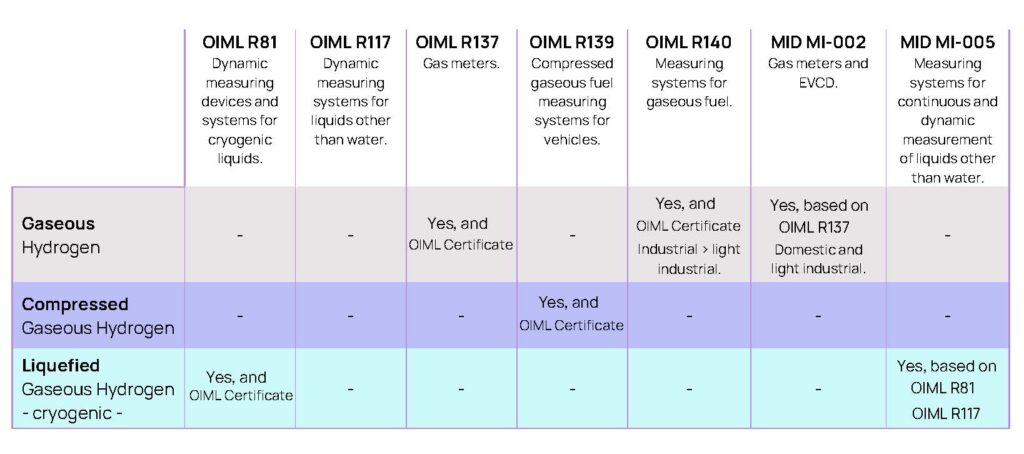This article was first published on this site on 21/07/2022 (date of first publication) and was updated with more recent/complete content on 13/06/2023.
Hydrogen is currently the focus of many initiatives, seminars, national and international working groups, as it is one of the elements on which important environmental sustainability solutions are being developed.
In particular, its use emerges as a fuel for vehicles (cars, ships, trucks, trains, buses) replacing hydrocarbons, with the associated storage and transport, as a source of energy for industrial uses (especially in the chemical and metallurgical sectors), and as a gas for domestic residential use.
In this article, we attempt to address in a simple way a complex topic of fundamental importance for many companies. We focus on the certification of hydrogen fiscal measuring instruments, giving an overview of how they can be certified and enter the market nowadays.
A fundamental premise is that the subject is constantly evolving for several reasons: we are in the early stages of the official use of this element in fiscal measurement; the technology is developing very rapidly; on the other hand, the laws, regulatory documents and standards are following technological progress more slowly; furthermore, there is not yet the availability of sufficient reference equipment (essential to carry out the first verification and type conformity checks) traceable to international standards.
Hydrogen fiscal measuring instruments can be classified into instruments for measuring hydrogen in the gaseous state and in the liquid state (compressed gaseous and cryogenic). For each of these, we specify the certification required in order to enter the markets.
Fiscal measuring instruments for hydrogen in its gaseous state not as a fuel, are those used in the chemical and metallurgical industries, while those for hydrogen in its gaseous state as a fuel are used both in the distribution network for residential and light industrial use and for larger measuring systems.
Instruments used for the fiscal measurement of hydrogen in its gaseous state not as fuel by the chemical and metallurgical industries unfortunately do not currently have a definite route to certification. The OIML Recommendation R140 ed. 2007 (Measuring systems for gaseous fuel), which is useful for international market entry, would not be applicable for two reasons: 1) it deals with gas as a fuel and not as a chemical product; 2) hydrogen is not explicitly included in this document at the moment.
With regard to entry into the European and Italian markets, the MID Directive 2014/32/EU – Annex MI-002 is also not applicable here for two reasons: 1) it also deals with gas as a fuel and not as a chemical product; 2) it only applies to light industry, whereas we are beyond that area.
Instruments used for the fiscal measurement of hydrogen in its gaseous state as a fuel in the residential and light industrial fields can be certified according to OIML Recommendation R137 ed.2012 (Gas meters) for international market entry, as a basis for national type approval, and according to MID Directive 2014/32/EU – Annex MI-002, in order to enter the European and Italian markets.
Instruments used for the fiscal measurement of hydrogen in its gaseous state as fuel in the distribution network beyond light industry can only be certified according to OIML Recommendation R140 ed. 2007 (Measuring systems for gaseous fuel) for entry into the international, European and Italian markets, as a basis for national type certification. The MID Directive is not applicable because we are beyond the light industry limit1.
Instruments used for the fiscal measurement of hydrogen in its compressed gaseous state (CGH22) are those that are used to measure the refuelling of road vehicles, trains, boats, ships and aircraft. The certification of these instruments is expressly provided for in the OIML Recommendation R139 ed. 2018 (Compressed gaseous fuel measuring systems for vehicles), which to date serves for entry into any market, both international and European/Italian, as there is no ad hoc Directive. Once you have the certificate of conformity, you will need to convert it into the national type approval, depending on the Country you want to enter.
Instruments used for the fiscal measurement of hydrogen in its cryogenic liquid state (LGH23) are those that are used to determine the amount of hydrogen that is installed in a permanent location, or mounted for use in transport and/or other containment vessels or tanks. The certification of these instruments is possible thanks to OIML Recommendation R81 ed. 1998 (Dynamic measuring devices and systems for cryogenic liquids) for entry into the international market, always then working to obtain national type approval.
With regards to the certification of these instruments according to the MID Directive 2014/32/EU – Annex MI-005, in order to enter the European and Italian markets, it is good to keep in mind that to date, although officially the OIML R81 Recommendation is to be applied, nevertheless, in practice, the OIML R117 Recommendation ed. 2019 (Dynamic measuring systems for liquids other than water) is used for the following reasons: a) OIML R81 is not correctly referred to by the MID as a normative document and there is no table of correspondence between MID and OIML R81; b) OIML R81 is an outdated document (1998) and some standards are not adequately up-to-date; c) the tests prescribed by OIML R117 cover all the tests indicated in OIML R81.
Summarising the current situation on the possibility of certifying hydrogen fiscal measuring instruments, we include two recap tables, and remain hopeful for more interesting updates in the near future.


1 The boundary line between “light industry” and “industry” is defined by each State.
2 CGH2: Compressed Gaseous Hydrogen.
3 LGH2: Liquefied Gaseous Hydrogen.



